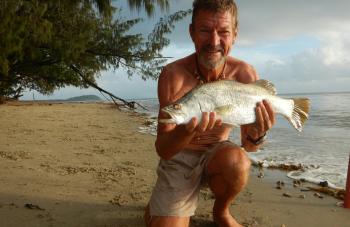It is safe to assume now that the wet season has played itself out, and what a mediocre wet season it was. Rainfall levels remained well under the average in the past few months and the next phase in the tropics is now moving into the dry season. Looking back I can’t remember a wet season when there was no serious threat of a cyclone.
There was occasional handy rainfall in the region in recent times and this when we probably saw the best inshore action along the coast. The beaches in particular had some grand moments when the bait supply was healthy and there were jelly prawn hatches. These triggered frenetic behaviour by particular predators including trevally, queenfish, barramundi, permit, giant herring and tarpon. Kilometres of water along the foreshore were lit up like a Christmas tree, as the hapless bait supply was hounded mercilessly on the early morning rising tides. It was a sight to behold.
At the same time, catch rates were also healthy around our major river and creek mouths with good numbers of barra and queenfish caught, especially when conditions were calm and the water clarity was premium. Meanwhile further upstream, the mangrove jack and golden snapper brigade also remained fairly consistent. With a cooler change in temperature imminent at some point this month I suspect the likes of barra will have a longer shelf life this season as the water temperatures have been so high for so long this year. Expect the inshore scene to remain fairly productive for a little while to come. It is also a great time of year to target some mud crabs in our local estuaries.
The reef fishing has definitely become patchy after such a long hot summer. The fishing was still reasonable, but has probably reached a low point for the year. Mixed bags of fish became the norm, with no particular species dominating catch rates. Ice coolers resembled a fruit salad with coral trout, nannygai, trevally, spangled emperor, red emperor, sweetlip and stripeys all thrown into one. The mackerel catches definitely tapered off as the days went on.
The upside is the reef fishing traditionally reignites during May with a change in the currents bringing up cooler water from the south. If you get your timing right you can experience blow out days when fish will keep coming over the side. The nannygai in particular can come on the bite like there is no tomorrow.
The winds tend to settle into a regular southeasterly pattern, and with the current coming from the same direction anchoring up on schools of fish becomes a lot easier. With the cooler water change, Spanish mackerel catches will also gradually increase.
The month of May is a bit of a crossover period where the winter and summer species are all still having a go and the fishing overall is generally productive.
Reads: 932
Local ‘Sharky’ Shane Down tapped into the rich supply of fish including this barra, along the Four Mile Beach when it fired up.




